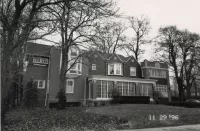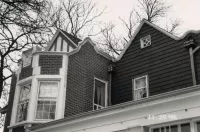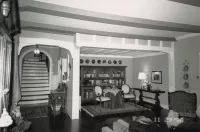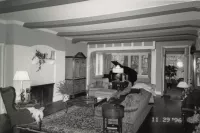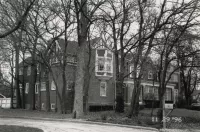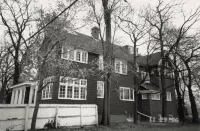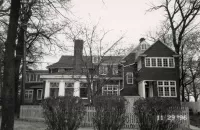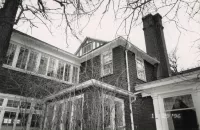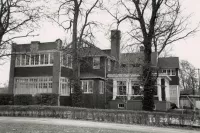Share what you know,
and discover more.
Share what you know,
and discover more.
May 02, 1997
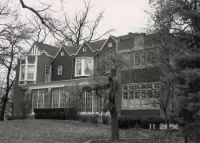
-

- Charmaine Bantugan
George R. Thorne House - National Register of Historic Places
Statement of Significance: The George R. Thorne Summer House, built in 1899, is a product of the dissemination of the Arts and Crafts philosophy and aesthetic in America and is a good example of the craftsmanship and design of architect Howard Van Doren Shaw's early residential architecture. The house meets Criterion C in the area of architecture as a late 19th century eclectic residence combining Tudor Revival, Shingle Style, Classical Revival, and Arts and Crafts influences. Shaw, a prominent architect of eclectic country houses, was inspired by the English Arts and Crafts movement and promoted its precepts in tum-of the-century midwestern residential architecture. Seven Cottage Row, as an example of Shaw's interpretation of the Arts and Crafts movement, displays many design features that would dominate Shaw's work throughout his career. The house was designed as one of the original summer cottages of the Midlothian Country Club for George R. Thorne, the primary founder of the club and the partner of Aaron Montgomery Ward in the founding of the Montgomery Ward's mail order empire. Initially a tum-of-the-century summer home for a prominent family, the 1914 additions and alterations by architect N. Max Dunning are sympathetic in styling and scale to the original Shaw design, and reflect the house's evolution to use as a year-round family home. The period of significance for the locally significant house is 1899, when the house was completed, to 1914 when the house was remodeled HISTORY In the late 1800s, farm houses dotted the rural landscape 18 miles southwest of Chicago of what is now Midlothian. In 1898, several wealthy Chicagoans decided to build a new golf club removed from the primary summer-house area of Chicago's North Shore. Concerned with privacy, the founders chose a site that was described by a writer in 1907 as "grand stretches of prairie, uncouth, wild and rough, swamps, groves, plowed land and barrens." The site actually offered a picturesque moor among rolling hills on one of the highest points in Cook County, three miles from Blue Island and over two miles from the Rock Island Railway. Conceptually, the club would be an isolated summer colony for the families to play, relax, and socialize. The club was organized on January 4, 1898, and chartered by the State of Illinois on January 22, 1898. The first president of the club was George R. Thorne. As golf was to be the primary function of the club, and golf is a Scottish game, the club members chose the name Midlothian from Sir Walter Scott's novel The Heart of Midlothian. According to the club historians, the original sod for the fairways was imported from Midlothian, Scotland. The course was laid out by Herbert J. Tweedie, a prominent golf course architect. He designed a nine-hole practice course, and a full eighteen-hole course on 208 hilly acres. Because of its distance from the city, the club had cottages and a guest house that could offer overnight accommodations for over 100 members. Several members owned their own cottages, such as the George R. Thorne Summer House at 7 Cottage Row, while other members rented cottages, which were available by the night, week, month, or season. The main clubhouse, designed by Frost and Gr2mger, contained offices, guest suites, a dining room, reception parlor, and a ballroom, and played host to many Midlothian social events. Aside from golf, the club offered riding, hunting, and polo for the members' pleasure. Transportation was a problem in the early days of the club. Club members established the Midlothian train depot on the Chicago and Rock Island line, but it was over two miles away. Carriages and buses proved to be unsatisfactory, so the directors of the club formed their own railroad, the Midlothian and Blue Island Railway, with the slogan "the only golf railway in the world". They built a spur line from Midlothian station, conveying passengers on the "Midlothian Limited", consisting of a small locomotive and two passenger coaches, right to the clubhouse. According to club historians, Midlothian became the only club in the world to have its own railway line. Midlothian Country Club flourished, and in 1907 boasted an impressive membership of 400 of Chicago's most prominent citizens, including Marshall Field and John Shedd. With some display of boosterism, the club was described in that year thusly: "Midlothian, the largest country club in America and Chicago's greatest country home, covers a magnificent sweep of rolling, wooded prairie eighteen miles to the southwest of the city. Rolling moor, grand expanses of flower sprinkled lowland, a beautiful grove of virgin oaks, and 208 acres of lawn, ornamented with rows of willows and groves of oak, between which run the lanes of the fair greens - that is Midlothian." By 1915, interest in the Midlothian area began to develop among non-members. Land around the club, including tracts of farmland owned by German and English settlers, was sub-divided into blocks and lots, and homes and business establishments were built. A village began to emerge to the east of the club. In 1924 the Midlothian Development Association was formed and in 1927 the Village of Midlothian was incorporated. Gradually, the area between the club and Blue Island has filled in with development. Cottage Row, along the crest of the hill above the clubhouse and facing onto the golf course, was originally laid out in 13 lots. According to the February 25, 1899 edition of The Economist: The Midlothian Country Club at Midlothian on the Rock Island Railroad, just beyond Blue Island, has resulted in the creation of a summer colony at that place, and for their accommodations a number of beautiful cottages are about to be built. Designs have been prepared by Howard Van Doren Shaw, and comprise a number of picturesque examples of architecture, involving an expenditure of probably $25,000 in all. Eight houses will be built, four of which will be for George R. Thorne, and one each for Reuben Donnelly, James O, Hinckley and Oren B. Taft. They will be constructed of a variety of materials, including frame, cement, and brick veneer. They will be nicely finished, and will make very attractive summer homes The eight houses mentioned above were built on lots 1, 2, 3, 5, 6, 8, 9, and II, Lots 1, 2, 3, and 8 were commissioned by George R. Thorne, lot 5 was built for J. C. Conley, lot 6 was built for J. 0. Hinkley, lot 8 was built for R. H. Donnelly, and lot 11 was built for Oren B. Taft. Lots I, 2, 3, 5, 6, 7, and 9 became cottage numbers 1, 2, 3, 5, 6, 7, and 8, respectively. All were built as summer residences for the Midlothian Country Club members. For his personal summer cottage, Thorne chose lot 8, which became cottage 7. He sold cottages 1,2, and 3 to other club members in 1901 and 1902. George Robinson Thorne, the key individual in the development of the Midlothian Country Club and Cottage Row, had long been a prominent Chicago citizen and was approaching retirement age when he took on the Midlothian Country Club project. Bom on a farm in Vergennes, Vermont on September 29, 1837, he was the son of Sarah Frost Thorne (1794-1854) and Hallett Thorne (1790-1872), who were Quakers from Flushing, Long Island. Thorne left Vergennes for Kalamazoo, Michigan in 1858, where he worked as a clerk in a dry goods store until the Civil War. He enlisted in the army and served as a Lieutenant Quartermaster and was stationed in St. Louis, Missouri. During the fall of 1863, Thorne briefly returned to Kalamazoo to marry Ellen Cobb, daughter of Merritt D. Cobb, on September 2. He resumed his post in St. Louis until the end of the Civil War, when he was then stationed briefly out West in connection with Native American reservation disputes, serving under General Custer. In 1865, Thorne returned to his wife in Kalamazoo, and met his future business partner A. Montgomery Ward, by 1867, Thorne, along with his wife's family, including her father and two sisters, moved to Chicago. Thorne and his father-in-law opened a retail grocery and liquor store that was destroyed by the fire in 1871, and immediately following, Thorne began a partnership in a lumber business. When that went broke in 1873, Thorne invested $800 into a partnership with A. Montgomery Ward, who had married Ellen Thorne's sister, Elizabeth. Thorn, e's investment provided much needed capital to Montgomery Ward & Company, and his retail experience proved useful as well, as he correlated a list of merchandise for distribution that became the first of the famous Montgomery Ward catalogs. A. Montgomery Ward had begun his business in 1872, initially as a mail order house to supply fanners. Although several people found the concept novel, many were skeptical, and Ward had a difficult time finding investors. With Thorne's involvement, the business quickly expanded and became highly successful, Thorne's sons followed him into the business, William in 1886, Charles in 1889, George in 1892, James in 1893, and Robert in 1897. Although Ward initially had controlling interest in the company, by 1893 he transferred controlling stock to George Thorne so that the future of Montgomery Ward would continue under the direction of Thorne's sons, who were running the company by the turn of the century. By that time, Thorne was in his semi-retirement, but perhaps his biggest endeavor was founding and running the Midlothian Country Club. He continued his advisory role at Montgomery Ward & Company until 1905, when he officially retired. He spent the remainder of his life presiding over his golf club and traveling until his death in 1918 at the age of 81, In 1913, the Thorne family sold the summer house on Cottage Row to Marvin and Edith Pool, who owned it until 1922.
George R. Thorne House - National Register of Historic Places
Statement of Significance: The George R. Thorne Summer House, built in 1899, is a product of the dissemination of the Arts and Crafts philosophy and aesthetic in America and is a good example of the craftsmanship and design of architect Howard Van Doren Shaw's early residential architecture. The house meets Criterion C in the area of architecture as a late 19th century eclectic residence combining Tudor Revival, Shingle Style, Classical Revival, and Arts and Crafts influences. Shaw, a prominent architect of eclectic country houses, was inspired by the English Arts and Crafts movement and promoted its precepts in tum-of the-century midwestern residential architecture. Seven Cottage Row, as an example of Shaw's interpretation of the Arts and Crafts movement, displays many design features that would dominate Shaw's work throughout his career. The house was designed as one of the original summer cottages of the Midlothian Country Club for George R. Thorne, the primary founder of the club and the partner of Aaron Montgomery Ward in the founding of the Montgomery Ward's mail order empire. Initially a tum-of-the-century summer home for a prominent family, the 1914 additions and alterations by architect N. Max Dunning are sympathetic in styling and scale to the original Shaw design, and reflect the house's evolution to use as a year-round family home. The period of significance for the locally significant house is 1899, when the house was completed, to 1914 when the house was remodeled HISTORY In the late 1800s, farm houses dotted the rural landscape 18 miles southwest of Chicago of what is now Midlothian. In 1898, several wealthy Chicagoans decided to build a new golf club removed from the primary summer-house area of Chicago's North Shore. Concerned with privacy, the founders chose a site that was described by a writer in 1907 as "grand stretches of prairie, uncouth, wild and rough, swamps, groves, plowed land and barrens." The site actually offered a picturesque moor among rolling hills on one of the highest points in Cook County, three miles from Blue Island and over two miles from the Rock Island Railway. Conceptually, the club would be an isolated summer colony for the families to play, relax, and socialize. The club was organized on January 4, 1898, and chartered by the State of Illinois on January 22, 1898. The first president of the club was George R. Thorne. As golf was to be the primary function of the club, and golf is a Scottish game, the club members chose the name Midlothian from Sir Walter Scott's novel The Heart of Midlothian. According to the club historians, the original sod for the fairways was imported from Midlothian, Scotland. The course was laid out by Herbert J. Tweedie, a prominent golf course architect. He designed a nine-hole practice course, and a full eighteen-hole course on 208 hilly acres. Because of its distance from the city, the club had cottages and a guest house that could offer overnight accommodations for over 100 members. Several members owned their own cottages, such as the George R. Thorne Summer House at 7 Cottage Row, while other members rented cottages, which were available by the night, week, month, or season. The main clubhouse, designed by Frost and Gr2mger, contained offices, guest suites, a dining room, reception parlor, and a ballroom, and played host to many Midlothian social events. Aside from golf, the club offered riding, hunting, and polo for the members' pleasure. Transportation was a problem in the early days of the club. Club members established the Midlothian train depot on the Chicago and Rock Island line, but it was over two miles away. Carriages and buses proved to be unsatisfactory, so the directors of the club formed their own railroad, the Midlothian and Blue Island Railway, with the slogan "the only golf railway in the world". They built a spur line from Midlothian station, conveying passengers on the "Midlothian Limited", consisting of a small locomotive and two passenger coaches, right to the clubhouse. According to club historians, Midlothian became the only club in the world to have its own railway line. Midlothian Country Club flourished, and in 1907 boasted an impressive membership of 400 of Chicago's most prominent citizens, including Marshall Field and John Shedd. With some display of boosterism, the club was described in that year thusly: "Midlothian, the largest country club in America and Chicago's greatest country home, covers a magnificent sweep of rolling, wooded prairie eighteen miles to the southwest of the city. Rolling moor, grand expanses of flower sprinkled lowland, a beautiful grove of virgin oaks, and 208 acres of lawn, ornamented with rows of willows and groves of oak, between which run the lanes of the fair greens - that is Midlothian." By 1915, interest in the Midlothian area began to develop among non-members. Land around the club, including tracts of farmland owned by German and English settlers, was sub-divided into blocks and lots, and homes and business establishments were built. A village began to emerge to the east of the club. In 1924 the Midlothian Development Association was formed and in 1927 the Village of Midlothian was incorporated. Gradually, the area between the club and Blue Island has filled in with development. Cottage Row, along the crest of the hill above the clubhouse and facing onto the golf course, was originally laid out in 13 lots. According to the February 25, 1899 edition of The Economist: The Midlothian Country Club at Midlothian on the Rock Island Railroad, just beyond Blue Island, has resulted in the creation of a summer colony at that place, and for their accommodations a number of beautiful cottages are about to be built. Designs have been prepared by Howard Van Doren Shaw, and comprise a number of picturesque examples of architecture, involving an expenditure of probably $25,000 in all. Eight houses will be built, four of which will be for George R. Thorne, and one each for Reuben Donnelly, James O, Hinckley and Oren B. Taft. They will be constructed of a variety of materials, including frame, cement, and brick veneer. They will be nicely finished, and will make very attractive summer homes The eight houses mentioned above were built on lots 1, 2, 3, 5, 6, 8, 9, and II, Lots 1, 2, 3, and 8 were commissioned by George R. Thorne, lot 5 was built for J. C. Conley, lot 6 was built for J. 0. Hinkley, lot 8 was built for R. H. Donnelly, and lot 11 was built for Oren B. Taft. Lots I, 2, 3, 5, 6, 7, and 9 became cottage numbers 1, 2, 3, 5, 6, 7, and 8, respectively. All were built as summer residences for the Midlothian Country Club members. For his personal summer cottage, Thorne chose lot 8, which became cottage 7. He sold cottages 1,2, and 3 to other club members in 1901 and 1902. George Robinson Thorne, the key individual in the development of the Midlothian Country Club and Cottage Row, had long been a prominent Chicago citizen and was approaching retirement age when he took on the Midlothian Country Club project. Bom on a farm in Vergennes, Vermont on September 29, 1837, he was the son of Sarah Frost Thorne (1794-1854) and Hallett Thorne (1790-1872), who were Quakers from Flushing, Long Island. Thorne left Vergennes for Kalamazoo, Michigan in 1858, where he worked as a clerk in a dry goods store until the Civil War. He enlisted in the army and served as a Lieutenant Quartermaster and was stationed in St. Louis, Missouri. During the fall of 1863, Thorne briefly returned to Kalamazoo to marry Ellen Cobb, daughter of Merritt D. Cobb, on September 2. He resumed his post in St. Louis until the end of the Civil War, when he was then stationed briefly out West in connection with Native American reservation disputes, serving under General Custer. In 1865, Thorne returned to his wife in Kalamazoo, and met his future business partner A. Montgomery Ward, by 1867, Thorne, along with his wife's family, including her father and two sisters, moved to Chicago. Thorne and his father-in-law opened a retail grocery and liquor store that was destroyed by the fire in 1871, and immediately following, Thorne began a partnership in a lumber business. When that went broke in 1873, Thorne invested $800 into a partnership with A. Montgomery Ward, who had married Ellen Thorne's sister, Elizabeth. Thorn, e's investment provided much needed capital to Montgomery Ward & Company, and his retail experience proved useful as well, as he correlated a list of merchandise for distribution that became the first of the famous Montgomery Ward catalogs. A. Montgomery Ward had begun his business in 1872, initially as a mail order house to supply fanners. Although several people found the concept novel, many were skeptical, and Ward had a difficult time finding investors. With Thorne's involvement, the business quickly expanded and became highly successful, Thorne's sons followed him into the business, William in 1886, Charles in 1889, George in 1892, James in 1893, and Robert in 1897. Although Ward initially had controlling interest in the company, by 1893 he transferred controlling stock to George Thorne so that the future of Montgomery Ward would continue under the direction of Thorne's sons, who were running the company by the turn of the century. By that time, Thorne was in his semi-retirement, but perhaps his biggest endeavor was founding and running the Midlothian Country Club. He continued his advisory role at Montgomery Ward & Company until 1905, when he officially retired. He spent the remainder of his life presiding over his golf club and traveling until his death in 1918 at the age of 81, In 1913, the Thorne family sold the summer house on Cottage Row to Marvin and Edith Pool, who owned it until 1922.
May 02, 1997
George R. Thorne House - National Register of Historic Places
Statement of Significance:The George R. Thorne Summer House, built in 1899, is a product of the dissemination of the Arts and Crafts philosophy and aesthetic in America and is a good example of the craftsmanship and design of architect Howard Van Doren Shaw's early residential architecture. The house meets Criterion C in the area of architecture as a late 19th century eclectic residence combining Tudor Revival, Shingle Style, Classical Revival, and Arts and Crafts influences. Shaw, a prominent architect of eclectic country houses, was inspired by the English Arts and Crafts movement and promoted its precepts in tum-of the-century midwestern residential architecture. Seven Cottage Row, as an example of Shaw's interpretation of the Arts and Crafts movement, displays many design features that would dominate Shaw's work throughout his career. The house was designed as one of the original summer cottages of the Midlothian Country Club for George R. Thorne, the primary founder of the club and the partner of Aaron Montgomery Ward in the founding of the Montgomery Ward's mail order empire. Initially a tum-of-the-century summer home for a prominent family, the 1914 additions and alterations by architect N. Max Dunning are sympathetic in styling and scale to the original Shaw design, and reflect the house's evolution to use as a year-round family home. The period of significance for the locally significant house is 1899, when the house was completed, to 1914 when the house was remodeled
HISTORY
In the late 1800s, farm houses dotted the rural landscape 18 miles southwest of Chicago of what is now Midlothian. In 1898, several wealthy Chicagoans decided to build a new golf club removed from the primary summer-house area of Chicago's North Shore. Concerned with privacy, the founders chose a site that was described by a writer in 1907 as "grand stretches of prairie, uncouth, wild and rough, swamps, groves, plowed land and barrens." The site actually offered a picturesque moor among rolling hills on one of the highest points in Cook County, three miles from Blue Island and over two miles from the Rock Island Railway. Conceptually, the club would be an isolated summer colony for the families to play, relax, and socialize. The club was organized on January 4, 1898, and chartered by the State of Illinois on January 22, 1898. The first president of the club was George R. Thorne. As golf was to be the primary function of the club, and golf is a Scottish game, the club members chose the name Midlothian from Sir Walter Scott's novel The Heart of Midlothian. According to the club historians, the original sod for the fairways was imported from Midlothian, Scotland. The course was laid out by Herbert J. Tweedie, a prominent golf course architect. He designed a nine-hole practice course, and a full eighteen-hole course on 208 hilly acres. Because of its distance from the city, the club had cottages and a guest house that could offer overnight accommodations for over 100 members. Several members owned their own cottages, such as the George R. Thorne Summer House at 7 Cottage Row, while other members rented cottages, which were available by the night, week, month, or season. The main clubhouse, designed by Frost and Gr2mger, contained offices, guest suites, a dining room, reception parlor, and a ballroom, and played host to many Midlothian social events. Aside from golf, the club offered riding, hunting, and polo for the members' pleasure. Transportation was a problem in the early days of the club. Club members established the Midlothian train depot on the Chicago and Rock Island line, but it was over two miles away. Carriages and buses proved to be unsatisfactory, so the directors of the club formed their own railroad, the Midlothian and Blue Island Railway, with the slogan "the only golf railway in the world". They built a spur line from Midlothian station, conveying passengers on the "Midlothian Limited", consisting of a small locomotive and two passenger coaches, right to the clubhouse. According to club historians, Midlothian became the only club in the world to have its own railway line. Midlothian Country Club flourished, and in 1907 boasted an impressive membership of 400 of Chicago's most prominent citizens, including Marshall Field and John Shedd. With some display of boosterism, the club was described in that year thusly:
"Midlothian, the largest country club in America and Chicago's greatest country home, covers a magnificent sweep of rolling, wooded prairie eighteen miles to the southwest of the city. Rolling moor, grand expanses of flower sprinkled lowland, a beautiful grove of virgin oaks, and 208 acres of lawn, ornamented with rows of willows and groves of oak, between which run the lanes of the fair greens - that is Midlothian."
By 1915, interest in the Midlothian area began to develop among non-members. Land around the club, including tracts of farmland owned by German and English settlers, was sub-divided into blocks and lots, and homes and business establishments were built. A village began to emerge to the east of the club. In 1924 the Midlothian Development Association was formed and in 1927 the Village of Midlothian was incorporated. Gradually, the area between the club and Blue Island has filled in with development.
Cottage Row, along the crest of the hill above the clubhouse and facing onto the golf course, was originally laid out in 13 lots. According to the February 25, 1899 edition of The Economist:
The Midlothian Country Club at Midlothian on the Rock Island Railroad, just beyond Blue Island, has resulted in the creation of a summer colony at that place, and for their accommodations a number of beautiful cottages are about to be built. Designs have been prepared by Howard Van Doren Shaw, and comprise a number of picturesque examples of architecture, involving an expenditure of probably $25,000 in all. Eight houses will be built, four of which will be for George R. Thorne, and one each for Reuben Donnelly, James O, Hinckley and Oren B. Taft. They will be constructed of a variety of materials, including frame, cement, and brick veneer. They will be nicely finished, and will make very attractive summer homes
The eight houses mentioned above were built on lots 1, 2, 3, 5, 6, 8, 9, and II, Lots 1, 2, 3, and 8 were commissioned by George R. Thorne, lot 5 was built for J. C. Conley, lot 6 was built for J. 0. Hinkley, lot 8 was built for R. H. Donnelly, and lot 11 was built for Oren B. Taft. Lots I, 2, 3, 5, 6, 7, and 9 became cottage numbers 1, 2, 3, 5, 6, 7, and 8, respectively. All were built as summer residences for the Midlothian Country Club members. For his personal summer cottage, Thorne chose lot 8, which became cottage 7. He sold cottages 1,2, and 3 to other club members in 1901 and 1902.
George Robinson Thorne, the key individual in the development of the Midlothian Country Club and Cottage Row, had long been a prominent Chicago citizen and was approaching retirement age when he took on the Midlothian Country Club project. Bom on a farm in Vergennes, Vermont on September 29, 1837, he was the son of Sarah Frost Thorne (1794-1854) and Hallett Thorne (1790-1872), who were Quakers from Flushing, Long Island. Thorne left Vergennes for Kalamazoo, Michigan in 1858, where he worked as a clerk in a dry goods store until the Civil War. He enlisted in the army and served as a Lieutenant Quartermaster and was stationed in St. Louis, Missouri. During the fall of 1863, Thorne briefly returned to Kalamazoo to marry Ellen Cobb, daughter of Merritt D. Cobb, on September 2. He resumed his post in St. Louis until the end of the Civil War, when he was then stationed briefly out West in connection with Native American reservation disputes, serving under General Custer. In 1865, Thorne returned to his wife in Kalamazoo, and met his future business partner A. Montgomery Ward, by 1867, Thorne, along with his wife's family, including her father and two sisters, moved to Chicago. Thorne and his father-in-law opened a retail grocery and liquor store that was destroyed by the fire in 1871, and immediately following, Thorne began a partnership in a lumber business. When that went broke in 1873, Thorne invested $800 into a partnership with A. Montgomery Ward, who had married Ellen Thorne's sister, Elizabeth.
Thorn, e's investment provided much needed capital to Montgomery Ward & Company, and his retail experience proved useful as well, as he correlated a list of merchandise for distribution that became the first of the famous Montgomery Ward catalogs. A. Montgomery Ward had begun his business in 1872, initially as a mail order house to supply fanners. Although several people found the concept novel, many were skeptical, and Ward had a difficult time finding investors. With Thorne's involvement, the business quickly expanded and became highly successful, Thorne's sons followed him into the business, William in 1886, Charles in 1889, George in 1892, James in 1893, and Robert in 1897. Although Ward initially had controlling interest in the company, by 1893 he transferred controlling stock to George Thorne so that the future of Montgomery Ward would continue under the direction of Thorne's sons, who were running the company by the turn of the century. By that time, Thorne was in his semi-retirement, but perhaps his biggest endeavor was founding and running the Midlothian Country Club. He continued his advisory role at Montgomery Ward & Company until 1905, when he officially retired. He spent the remainder of his life presiding over his golf club and traveling until his death in 1918 at the age of 81, In 1913, the Thorne family sold the summer house on Cottage Row to Marvin and Edith Pool, who owned it until 1922.
Posted Date
Apr 07, 2022
Historical Record Date
May 02, 1997
Source Name
United States Department of Interior - National Park Service
Source Website
Delete Story
Are you sure you want to delete this story?


